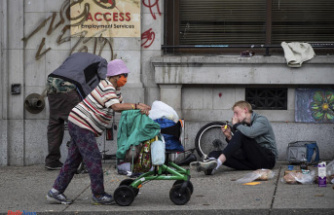Instead of sporting news from the Borussia Dortmund training camp, the focus today is on striker Sébastien Haller's illness. The 28-year-old new signing had to leave his team-mates in Bad Ragaz, Switzerland, because a tumor was discovered in his testicles. BVB sports director Sebastian Kehl says that the whole of Borussia is in shock. Testicular cancer is often behind such a tumor. Tumors in the testicles were only recently discovered in two other professionals: Marco Richter from Hertha BSC and Timo Baumgartl from Union Berlin. Timo Baumgartl, who was diagnosed with testicular cancer, encourages his Dortmund colleague. The tumor in Baumgartl's testicles has now been successfully removed. The most important questions and answers about testicular cancer.
According to estimates by the Robert Koch Institute (RKI), between 4,100 and 4,200 men in Germany develop testicular cancer every year. With a share of 1.6 percent of all cancers in men, testicular cancer is a rather rare cancer. It mainly affects younger men between the ages of 25 and 45. According to the RKI, testicular cancer is the most common malignant tumor in men in this age group. The average age for testicular cancer is 38 years.
There are different types of cells in the testicles. However, in about 90 percent of cases, the malignant tumors arise from the germ cells, which is why they are also referred to as germ cell tumors, the German Cancer Society informs. The small rest of the tumors arise from the supporting and connective tissue of the testicles. They are referred to as non-germinal tumors. Physicians differentiate between seminomas and non-seminomas in germ cell tumors. A seminoma develops from abnormal stem cells in the sperm. Non-seminomas are forms of testicular cancer that arise from other types of tissue, such as the yolk sac tumor or choriocarcinoma. In around 95 percent of cases, testicular cancer affects only one of the two testicles.
The exact causes of testicular cancer are not yet known, but researchers have identified some risk factors. Undescended testicles are a proven risk factor. Men who have had testicular cancer themselves or whose closest relatives have had a tumor in their testicles are at increased risk. Infertility is also considered a risk factor. According to the RKI, a birth weight of less than 2500 grams or more than 4500 grams is discussed as a possible risk factor for testicular cancer in medicine. Whether a man gets testicular cancer or not can be determined in the womb. Testicular cancer can arise from a precursor called TIN (testicular intraepithelial neoplasia). Behind it are germ cells that already develop incorrectly in the embryo. Hormone imbalance during pregnancy is suspected to be one of the reasons. Lifestyle and environmental factors, on the other hand, do not play a role in the development of testicular cancer according to current knowledge.
As with other types of cancer, the chances of recovery are better the earlier the cancer is detected. Testicular cancer is almost always curable in the early stages, but there are good chances of recovery even in advanced stages. "96 percent of the sick men get well again and can go about their work. Tumors of the testicles are therefore an extremely rare cause of death," says the German Cancer Society.
If it is a small testicular tumor, sufferers usually have no symptoms. Painless hardening in the scrotum occurs most commonly in testicular cancer. The surface of the testicle feels bumpy or nodular. An enlarged testicle can also indicate a tumor. It can be caused by the tumor itself or an accumulation of water. In some sufferers, the enlarged testicles are accompanied by a pulling sensation. In rare cases, pain in the area of the testicles also indicates cancer.
The Society for Urology recommends that boys and men between the ages of 14 and 45 feel their testicles themselves once a month. It is best to feel the testicles while standing under a warm shower or after a warm bath. The reason: the skin of the scrotum is so relaxed and the testicles feel good. Men should pay attention to hardening or size changes. If you find hardening, you should compare the two testicles - differences and changes can usually be seen better in comparison.
Feel the testicles in three steps:
From the age of 45, a physical examination with palpation of the groin, penis, testicles and prostate is recommended annually for cancer screening. If you have a family history of prostate cancer, you should start at the age of 40. You can find more information about testicular cancer screening at "Hodencheck.de".
In most cases, surgery is the first step in treatment, removing the tumor. In most cases, in order to remove all of the malignant tissue, the entire diseased testicle must be removed. Further therapy depends on the type of testicular tumor and how far the disease has progressed. Radiation or chemotherapy is often followed.
For most sufferers, only the cancerous testicle needs to be surgically removed. The remaining testicle is usually sufficient to maintain sexual desire and fertility. Under certain circumstances, semen production can be impaired after the disease. There are also cases where men have impaired sperm production even before testicular cancer.
Sources: BVB, Sportschau Twitter, T-Online, Apotheken Umschau, RKI, German Cancer Society 1, German Cancer Society 2, Net Doktor, AOK, testicular check












